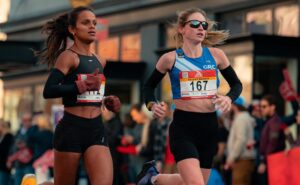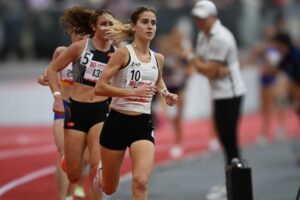The primary purpose of the U.S. Olympic Marathon Trials is to select the three women and three men who will represent the U.S. at the Olympic Games. But the women’s Trials have always included decent-sized fields, with the number of qualifiers ranging from a low of 118 in 1992 to a previous high of 267 in 1984. Though everyone lines up at the Trials technically having a shot at making the Olympic team, for many runners in the field, the race is their Olympic Games.
With 512 women and 260 men qualified for the 2020 race, it raises the question of how inclusive the Trials need to be. No one involved ever intended to have a field this large, so it seems inevitable that the women’s qualifying standard will get tougher in 2024 and beyond. This large Trials race, which has come about via a perfect storm of variables, wasn’t intentional, but it’s going to be wonderful.
Runners used teamwork, both in person and online, to make it to the Trials, and in the process, they created community around this event like we’ve never seen before. Each runner has a local army of supporters, plus an online following, who will be cheering them on in person or from afar. And most runners have local newspapers and/or TV stations eager to highlight their accomplishments, whether or not they understand the difference between qualifying for the Olympic Trials and the Olympic Games. There have never been so many eyes on a U.S. Olympic Marathon Trials.
Having a relatively easier standard keeps more women in the sport, or lures them back in, and that elevates the entire field. As the Atlanta Track Club’s Jay Holder told Chris Chavez in this episode of the Citius Mag podcast, “Your 2:42 marathoner of today could be your 2:24 marathoner of 2024. If there’s not someone there encouraging and supporting that, then that might not happen.”
Esther Atkins, who became a USA marathon champion and world championships team member, and Samantha (Bluske) Palmer, who is now a 2:29 marathoner, said recently that the goal of qualifying for the Trials helped keep them in the sport. And while the standard wasn’t what initially motivated Roberta Groner, it was one of her goals along the way, and now she, too, is a 2:29 marathoner, as well as the sixth-place finisher from last summer’s World Championships.
Some challenges and context
Many people agree that having a larger field and more attainable standard on the women’s side has done great things for the sport. That part is not particularly controversial. It’s easy for us to sit at our keyboards, however, and say that USATF should always have 500-person fields. But it’s more complicated than that.
I reached out to Mike Scott, who currently serves as the chairman of USA Track & Field’s Long Distance Running (LDR) Division, to help me further understand the factors that go into the USATF LDR committees’ decisions regarding the qualifying standards.
For one, we must consider the Ted Stevens Olympic and Amateur Sports Act, which dictates, among other things, that the qualifying standard for the U.S. Olympic Marathon Trials can’t be more difficult than the Olympic qualifying standard. That’s how we ended up with a 2:45:00 qualifying time for women this time around. The 2016 Olympic standard was 2:45:00, and when the USATF LDR committee set the 2020 standards, they had no way of knowing the standard would drop to 2:29:30, because it wasn’t announced until March 2019, after the qualifying window had already opened.
Without going into too much detail, the value of a Trials race in future years depends heavily on what World Athletics decides regarding the Olympic qualifying procedures going forward. If they move to a model that depends heavily on world ranking or if our new, tough qualifying standards (2:11:30 men/2:29:30 women) get even tougher, or even if they stay the same, it could lead to a scenario where the first three runners across the finish line at a U.S. Trials race wouldn’t necessarily make the Olympic team. That was a real concern for the 2020 Trials, especially for the men, but after USATF expressed its concern, World Athletics granted our Trials one-time gold label status, which saves the race this time.
If for some reason, the first three runners across the finish line are not guaranteed spots on the Olympic team, that devalues the race for all involved—USATF, the local organizing committee (LOC), and the TV broadcasters, who don’t want to have to explain a convoluted qualifying process to would-be fans. This likely affects just about everything else about the Trials—who is willing to bid to host the race, how much money can be made from the race, who wants to watch it, and who wants to televise it. For that reason, USATF has worked hard to protect that aspect of the Trials, though the decision is ultimately up to World Athletics.
Putting on the Trials is expensive. This document outlines the associated costs, in general terms. We don’t know how much the Atlanta Track Club will pay to host the 2020 event, but according to the linked document, they needed to pay a $100,000 rights fee, spend at least $75,000 to market and publicize the Trials, provide the prize money ($480,000), and cover all the costs associated with putting on a race (security, medical, facilities, hospitality, and so on). USATF requires only that the LOC pay for “A” qualifiers’ travel and lodging, but expecting a much smaller field, the Atlanta Track Club committed to paying for all qualifiers, and that will end up costing them twice as much as they anticipated.
The potential income streams for the LOC, also outlined in the document, aren’t what you might expect, especially because any local sponsors can’t conflict with USATF’s or the USOC’s sponsors. The LOC generally has rights to ticket sales and on-premise food and beverage sales, but there aren’t many tickets to be sold at a marathon.
The bigger the field gets, the more expensive the race gets. Even if all of the B qualifiers cover their own hotel and travel, they still cost the LOC money. I’ve seen people saying things like, “If X can put on a 10,000 person race, surely the LOC and USATF can handle a 1,000-person race.” The major difference, Scott points out, is that the Trials is essentially a marathon with roughly 700 invited athletes. No race has 700 athletes in its professional field, and mass marathons have large fields who pay entry fees and can help offset some of the other costs.
Finally, the larger the field, the tougher the logistics. If anything goes poorly logistically in Atlanta—top athletes missing their bottles, falling, or traffic jams that interfere with the race—it’s going to be harder to make the case for a large field the next time around. Scott points out that not only is there going to be lapping on the Atlanta course, with the men’s and women’s races happening simultaneously, the various vehicles on the course (TV, media, etc.) might have a hard time getting through runner traffic on the narrower roads, especially with long fluid stations narrowing the road.
Potential solutions
Despite the challenges and costs associated with hosting the Olympic Marathon Trials, the OTQ (Olympic Trials qualifying time) has become the BQ (Boston Marathon qualifying time) of our sport’s very elite. It has raised the level of U.S. distance running, especially on the women’s side, and it’s one of the best things the sport has going for it right now. Instead of automatically reverting to the old model of smaller fields, I think it’s worth looking at how USATF and the running community might be able to build on this, or at least keep it going.
I don’t have a fully-formed solution, but here are some thoughts:
- Go back to holding the men’s and women’s Trials on different dates and in different locations. This means fewer runners total and a more affordable race for each LOC. Challenge: Believe it or not, 2016 was the first year that both the men’s and women’s Trials were on live TV, and I’m told that a big part of the appeal in televising the race was having both races on the same day. But at the same time, it was so much fun when all of the attention was focused on one race at a time.
- Consider having different levels of tiered perks. Have a tough A standard, which earns athletes hotel, travel, and bottle service. Have a still-tough B standard, where athletes get a place on the starting line, but none of the above perks. And there could even be a C standard, if we want to make the race even more inclusive, where athletes have to pay their own way and pay an entry fee for the race, as they do for most marathons.
- Offer some level of host family option to a limited number of athletes who can’t afford their own hotels, or offer a financial aid options to athletes who wouldn’t otherwise be able to make the trip.
- Offer individual donors the opportunity to sponsor a runner’s travel, hotel, and expenses.
- Hold the race on a course with fewer loops, to make lapping less of an issue. (Scott points out that closing down more miles of road will generally make both the race and the TV broadcast more expensive.)
- I’m curious if there are other possible funding streams that haven’t yet been considered, like additional companies funding athletes’ Trials participation, and getting credit for it, without somehow conflicting with the USATF/USOC sponsors. It seems like there should be creative ways to involve sponsors in an adjacent manner, without stepping on toes.
- Hold some type of mass destination race either the day of or the day after that helps cover some of the costs. (Atlanta is already doing this, as have others, but I wonder if there’s even more untapped opportunity there. And again, I wonder if there’s some way to make it feel more Trials adjacent, like calling it Atlanta 2020, or Road to Gold, so that the whole thing feels more brag-worthy and appealing to the masses.)
If you have any creative solutions for making a roughly 1,000 person race (500 men, 500 women) logistically possible and more affordable to the LOC, or other ideas, please let me know.
Scott said that nothing has been decided yet, and no formal discussions will begin until after the 2020 Trials. “The committees will have to examine the totality of whether it’s feasible to have a similar Trials next time—look at bidders, finances, and all those factors,” he said. In the meantime, let’s just appreciate the Atlanta Track Club for taking all of this on, and rolling with the punches when the field size ballooned beyond what anyone imagined.







You wrote: “There have never been so many eyes on a U.S. Olympic Marathon Trials.” You implicitly argue that this is due to the large fields. However, there was intense interest in the Olympic marathon trials in Japan, where the fields were tiny. I can’t remember the exact numbers, but there were less than a dozen women and only a few dozen men. So I don’t think you can assume that more runners equals more interest. I personally would prefer stricter qualifying times — say 2:15 for men and 2:35 for the women.
I don’t think you can equate what works and what has happened in Japan, vs the US. Japan is very much into the marathon as a culture. That is just not the case in the US. I agree (without real data obvciously) that part of the hype for the OT is due to the field size being so large and it being such an inclusive event. Its EVERYWHERE right now, because yoou have ~800 people freely promoting it all over insta and twitter and facebook, on top of all the sponsors pushing it. It seems like every major running club has a runner in the OT(mine has 3 going, the other 4 major clubs in the area all have multiples), which also gets it more attention from the rest of its members as its now a personalized interest.
Though with the standards you listed, we would see probably 40 people on each (assuming some of the 2:13-14 men and 2:35-36 women would have met the tigher standard if it was known) which is still a good sized and very open field.
The other factor is how the larger OT field affects sponsorship of these sub-elite atheletes. I am curious how many wouldn’t have as much help if they lose this spotlight, and I think that piece is helping bolster the US ranks.
The size of this year’s women’s field in Atlanta should be deemed a huge success, certainly not a failure. Let the OTQ remain somewhere between the BQ and the OQ. Let the Trials remain a big aspirational goal for women runners. The finances are another matter entirely, and it may be necessary to limit the budget requirements on the local organizing committee. Those who BQ pay their own expenses to Boston, and most who OTQ would pay their expenses to the Trials.
Why not have the Olympic Trials at an already established marathon? You solve the financial problems, and the Olympic hopefuls could run an hour before the field — Phoenix or Houston? I love the bigger fields.
This has been considered before, I assume, since Boston and New York hosted the 2008 Trials. (Smaller races have as well.) But they did the Trials races the day before their major marathons, and I assume that’s because there were reasons the race within a race wouldn’t work. One of the issues is sponsor conflicts between the race and the USOC and USATF. But maybe there are ways around such things.
The 2000 men’s trials in Pittsburgh were held an hour or so before the open marathon. And I believe earlier trials were shown on live TV (96, when the men’s live race was intercut with tape of the women’s race from a week before, comes to mind).
As someone who measured both the 2000 and 2008 men’s courses, a criterium (loop) course provides many advantages, notably a concentration of spectators. I remember in 2007 at the men’s trials in NY Central Park felt like it was titling back and forth as fans ran from one side to the other to follow the action.
I agree with splitting the men and women’s events. Combining the races doesn’t increase coverage, it splits it. Media outlets aren’t going to double their staff or print space. But that means finding two hosts, double the logistics and weather and course concerns.
I’ll have to look back at what I wrote and maybe rephrase. 2016 was the first year that *both* were on live TV. (At least according to this https://www.multichannel.com/pr-feed/nbc-sports-present-unprecedented-live-coverage-us-olympic-team-trials-marathon-february-2016-393146) I asked Mike Scott if there could ever be a women Saturday/men Sunday type scenario, and he pointed out that something like that would likely result in the second race being shown live and the first one just being shown as highlights within the Sunday broadcast.
Excitement over the 2020 OTC will and should be enjoyed as special. This experience should not be a one-off. The qualifying standards will inevitably be more stringent in 2024. The USA elite and elite-in-training will raise their level to keep pace. Should that result in another 700+ racers, excellent. Having both races on the same day on the same course with different start times is a spectator’s pleasure. Bending the norm once every four years is part of our Olympic model. Replication may not be possible; neither should we toss aside the joy of this moment repeated once every four years. Watch the large crowds, the races, the course, and lighten up.
As a runner who was aspiring to hit the OTQ, that goal kept me motivated for many years. I would be saddened if the standards were changed to be out of reach for most. There were 500+ women that OTQ’ed, but I would venture to guess there might have been at least that many, if not double that many women, that were close enough to dream of hitting that mark.
The ideas proposed are good ones – i.e. have the B standard qualifiers pay their own way and pay an entry fee. The idea I had as I was running this morning was to consider limiting the field size. Similar to how Boston does things now – you have to hit the qualifying time AND you have to make the cut.
With this model there could more of a fixed cost and also no surprises in regards to the field size for race organizers From the get-go. For the athletes, it is more stressful as they will not know until the cut off if they have made it into the race…but at least they would continue to have that goal to chase…and if nothing else can still say they hit the OTQ even if they don’t get to compete in the race.
Can’t wait to watch my friends and teammates along with watching so many fierce women compete in Atlanta this weekend!